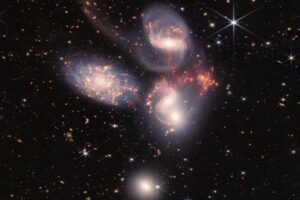
The Universe that today’s telescopes observe is not the Universe that was described in the textbooks of my youth. When all we had was the knowledge a big bang once happened and a local universe to observe, theorists were able to build beautiful theories of slow and gradual formation structure and growth as gravity pulled together first gas and later galaxies as large-scale structures gradually formed.
But with each new larger and better telescope, we’ve found things that made our simple understanding not just lacking in details, but also… just not quite right.
For instance, because it takes time for structures to form, our generally accepted theories didn’t anticipate the extremely bright galaxies that JWST is now finding.
Theorists working to reassess how the early universe should actually look haven’t, yet, explained the large bright systems we see, but a new paper appearing in The Astrophysical Journal Letters, with first author Claire E Williams, postulates the existence of small bright systems JWST should be able to find.
In new and more complex models, the team looked at how luminous matter and cold dark matter interact. In the largest systems, things work as expected. Massive blobs of slow-moving dark matter draw in and hold onto fast-moving hydrogen and helium, and compress the gas down into stars.
In smaller systems, we have more of a damped oscillator. The regular matter streams at supersonic speeds, and in small systems, they realized that fast-moving hydrogen and helium could blow right past the blobs of dark matter on its first pass and then fall back in millennia later. During this later infall, stars form all at once in massive star formation bursts that create small, exceptionally bright galaxies.
According to Williams, “The discovery of patches of small, bright galaxies in the early universe would confirm that we are on the right track with the cold dark matter model because only the velocity between two kinds of matter can produce the type of galaxy we’re looking for. If dark matter does not behave like standard cold dark matter and the streaming effect isn’t present, then these bright dwarf galaxies won’t be found and we need to go back to the drawing board.”
The nice thing about this theory is that it is very clear that “if you see this, then this thing is true, but if you don’t, here is a bigger thing you need to worry about that isn’t true.” One of the ongoing debates in modern astronomy is the temperature – or velocity of particles – in dark matter. There are a lot of different reasons to think Cold Dark matter just might not work, but it’s unclear. If this theory correctly predicts something no one knew to expect, then it’s pretty good evidence that cold dark matter does exist and our models just need more details – details like those in this paper.
